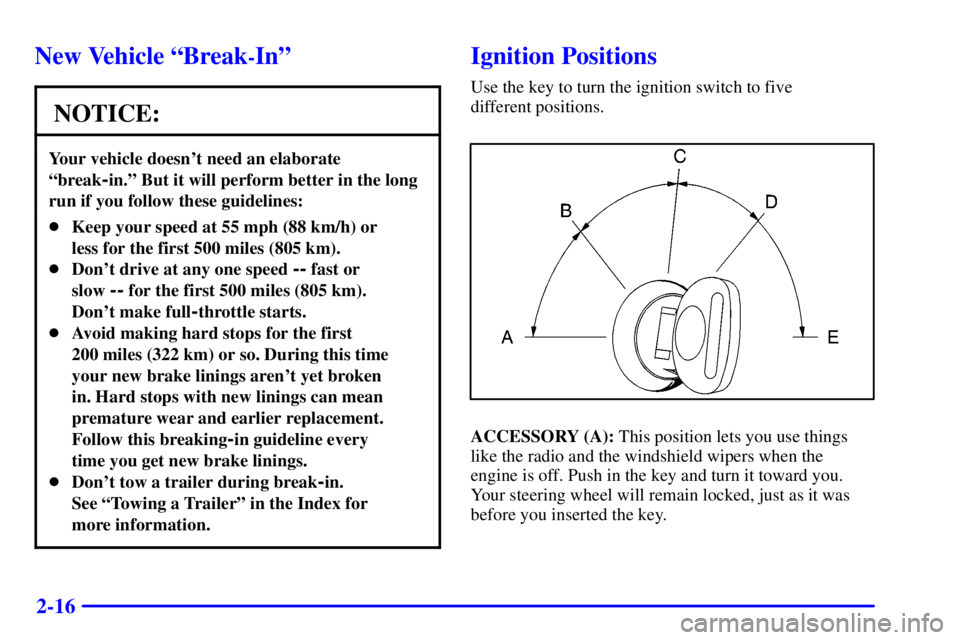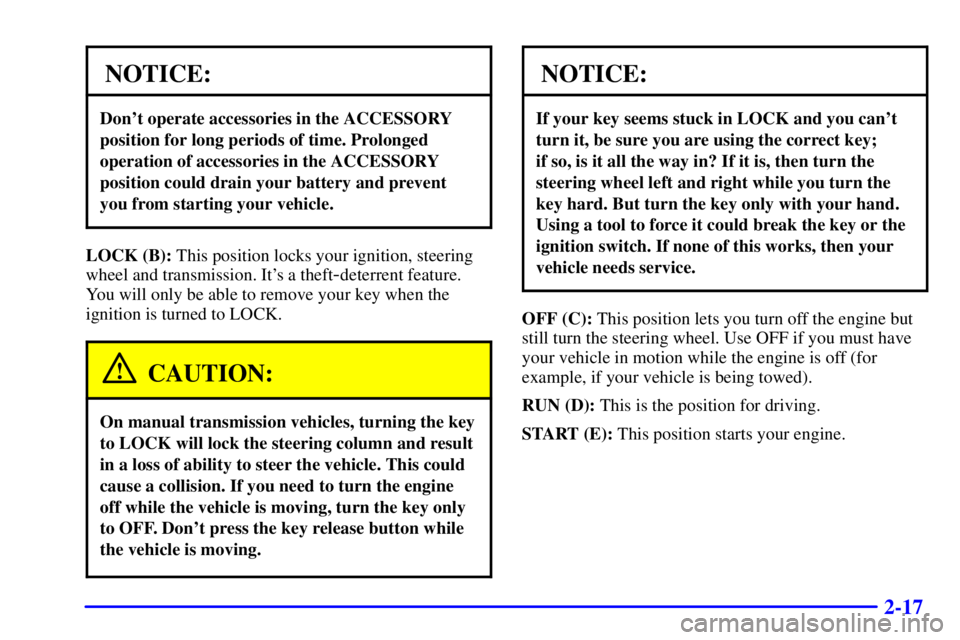Page 5 of 430
Table of Contents (cont'd)
Braking/Anti-lock Brakes
Steering
Driving Tips for Various Road Conditions
Off-Road DrivingRecreational Vehicle Towing
Loading Your Vehicle
Towing a Trailer Heating and Air Conditioning
Setting the Radio Clock
Radio/Cassette Player/CD PlayerRadio Theft-Deterrent Feature
Steering Wheel Controls (If Equipped)
Hazard Warning Flashers
Jump Starting
Towing Your VehicleEngine Overheating
Changing a Flat Tire
If You're Stuck
Problems on the Road Your Driving and the Road Comfort Controls and Audio Systems
Section
3
Section
4
Section
5
iii
Page 11 of 430
ix
For example,
these symbols
are used on an
original battery:
CAUTION
POSSIBLE
INJURY
PROTECT
EYES BY
SHIELDING
CAUSTIC
BATTERY
ACID COULD
CAUSE
BURNS
AVOID
SPARKS OR
FLAMES
SPARK OR
FLAME
COULD
EXPLODE
BATTERY
These symbols
are important
for you and
your passengers
whenever your
vehicle is
driven:
DOOR LOCK
UNLOCK
FASTEN
SEAT
BELTS
POWER
WINDOW
AIR BAG
These symbols
have to do with
your lamps:
MASTER
LIGHTING
SWITCH
TURN
SIGNALS
PARKING
LAMPS
HAZARD
WARNING
FLASHER
DAYTIME
RUNNING
LAMPS
FOG LAMPS
These symbols
are on some of
your controls:
WINDSHIELD
WIPER
WINDSHIELD
WASHER
WINDSHIELD
DEFROSTER
REAR
WINDOW
DEFOGGER
VENTILATING
FAN
These symbols
are used on
warning and
indicator lights:
ENGINE
COOLANT
TEMP
BATTERY
CHARGING
SYSTEM
BRAKE
COOLANT
ENGINE OIL
PRESSURE
ANTI-LOCK
BRAKES
Here are some
other symbols
you may see:
FUSE
LIGHTER
HORN
SPEAKER
FUEL
Vehicle Symbols
These are some of the symbols you may find on your vehicle.
Page 12 of 430
For
a More
Detailed Look at
What's Under the Hood
See Section 6
Service Station Guide
Oil Viscosity
Engine Oil
See Section 6
Engine Oil Dipstick
See Section 6Fuel
Use unleaded gas only,
87 Octane or higher.
See Section 6
Cooling System
See Section 5
Hood Release
See Section 6
Windshield Washer
Fluid
See Section 6
Spare Tire Pressure
See Section 6
Battery
See Section 6Tire Pressure
See Section 6
Page 69 of 430

2-
2-1
Section 2 Features and Controls
Here you can learn about the many standard and optional features on your vehicle, and information on starting,
shifting and braking. Also explained are the instrument panel and the warning systems that tell you if everything is
working properly
-- and what to do if you have a problem.
2
-2 Keys
2-4 Door Locks
2-6 Keyless Entry System (If Equipped)
2-9 Endgate/Liftgate
2-13 Theft
2-14 Content Theft-Deterrent (If Equipped)
2-15 Passlock�
2-16 New Vehicle ªBreak-Inº
2-16 Ignition Positions
2-18 Starting Your Engine
2-20 Engine Coolant Heater (If Equipped)
2-21 Automatic Transmission Operation
2-24 Manual Transmission Operation
2-26 Four-Wheel Drive (If Equipped)
2-33 Parking Brake
2-34 Shifting Into PARK (P)
(Automatic Transmission Only)
2
-37 Shifting Out of PARK (P)
(Automatic Transmission Only)2
-38 Parking Over Things That Burn
2-39 Engine Exhaust
2-39 Running Your Engine While You're Parked
(Automatic Transmission)
2
-40 Locking Rear Axle
2-40 Windows
2-43 Turn Signal/Multifunction Lever
2-49 Exterior Lamps
2-52 Interior Lamps
2-53 Mirrors
2-56 Storage Compartments
2-67 Accessory Power Outlets (If Equipped)
2-68 Sunroof (If Equipped)
2-69 HomeLink� Transmitter (If Equipped)
2-73 Instrument Panel
2-77 Warning Lights, Gages and Indicators
Page 77 of 430

2-9
Endgate/Liftgate
CAUTION:
It can be dangerous to drive with the rear
window, endgate or liftgate open because carbon
monoxide (CO) gas can come into your vehicle.
You can't see or smell CO. It can cause
unconsciousness and even death.
If you must drive with the rear window, endgate or
liftgate open or if electrical wiring or other cable
connections must pass through the seal between the
body and the rear window, endgate or liftgate:
�Make sure all other windows are shut.
�Turn the fan on your heating or cooling
system to its highest speed with the setting
on VENT or OUTSIDE AIR. That will
force outside air into your vehicle. See
ªComfort Controlsº in the Index.
�If you have air outlets on or under the
instrument panel, open them all the way.
See ªEngine Exhaustº in the Index.
Endgate Release
To open a mechanical lock system from the outside,
insert the key into the lock and turn it counterclockwise
to unlock the glass.
To open a power lock system from the outside, insert the
key into the lock button and turn counterclockwise.
All doors will unlock.
If your vehicle is equipped with the remote keyless entry
system, your vehicle does not have a lock on the
endgate. It is equipped with a pushbutton to release
the glass.
You may also use the keyless entry system, or the power
door locks, if your vehicle is so equipped.
Page 83 of 430

2-15 Testing the Alarm
The alarm can be tested by following these steps:
1. From inside the vehicle, lower the driver's window
and open the driver's door.
2. Activate the system by locking the doors with the
power door lock switch while the door is open, or
with the remote keyless entry transmitter.
3. Get out of the vehicle, close the door and wait for the
SECURITY light to go out.
4. Then reach in through the window, unlock the door
with the manual door lock and open the door.
This should set off the alarm.
If the alarm does not sound when it should but the
vehicle's headlamps flash, check to see if the horn
works. The horn fuse may be blown. To replace the fuse,
see ªFuses and Circuit Breakersº in the Index.
If the alarm does not sound or the vehicle's headlamps
do not flash, the vehicle should be serviced by an
authorized service center.
Passlock�
Your vehicle is equipped with the Passlock
theft
-deterrent system.
Passlock is a passive theft
-deterrent system. Passlock
enables fuel if the ignition lock cylinder is turned with a
valid key. If a correct key is not used or the ignition lock
cylinder is tampered with, fuel is disabled.
During normal operation, the SECURITY light will go
off approximately five seconds after the key is turned to
the RUN ignition position.
If the engine stalls and the SECURITY light flashes,
wait about 10 minutes until the light stops flashing
before trying to restart the engine. Remember to release
the key from START as soon as the engine starts.
If the engine does not start after three (3) tries, the
vehicle needs service.
If the engine is running and the SECURITY light comes
on, you will be able to restart the engine if you turn the
engine off. However, your Passlock system is not working
properly and must be serviced by your dealer. Your vehicle
is not protected by Passlock at this time. You may also
want to check the fuse (see ªFuses and Circuit Breakersº
in the Index). See your dealer for service.
In an emergency, call the GM Roadside Assistance
Center. See ªRoadside Assistanceº in the Index.
Page 84 of 430

2-16
New Vehicle ªBreak-Inº
NOTICE:
Your vehicle doesn't need an elaborate
ªbreak
-in.º But it will perform better in the long
run if you follow these guidelines:
�Keep your speed at 55 mph (88 km/h) or
less for the first 500 miles (805 km).
�Don't drive at any one speed
-- fast or
slow
-- for the first 500 miles (805 km).
Don't make full
-throttle starts.
�Avoid making hard stops for the first
200 miles (322 km) or so. During this time
your new brake linings aren't yet broken
in. Hard stops with new linings can mean
premature wear and earlier replacement.
Follow this breaking
-in guideline every
time you get new brake linings.
�Don't tow a trailer during break
-in.
See ªTowing a Trailerº in the Index for
more information.
Ignition Positions
Use the key to turn the ignition switch to five
different positions.
ACCESSORY (A): This position lets you use things
like the radio and the windshield wipers when the
engine is off. Push in the key and turn it toward you.
Your steering wheel will remain locked, just as it was
before you inserted the key.
Page 85 of 430

2-17
NOTICE:
Don't operate accessories in the ACCESSORY
position for long periods of time. Prolonged
operation of accessories in the ACCESSORY
position could drain your battery and prevent
you from starting your vehicle.
LOCK (B): This position locks your ignition, steering
wheel and transmission. It's a theft
-deterrent feature.
You will only be able to remove your key when the
ignition is turned to LOCK.
CAUTION:
On manual transmission vehicles, turning the key
to LOCK will lock the steering column and result
in a loss of ability to steer the vehicle. This could
cause a collision. If you need to turn the engine
off while the vehicle is moving, turn the key only
to OFF. Don't press the key release button while
the vehicle is moving.
NOTICE:
If your key seems stuck in LOCK and you can't
turn it, be sure you are using the correct key;
if so, is it all the way in? If it is, then turn the
steering wheel left and right while you turn the
key hard. But turn the key only with your hand.
Using a tool to force it could break the key or the
ignition switch. If none of this works, then your
vehicle needs service.
OFF (C): This position lets you turn off the engine but
still turn the steering wheel. Use OFF if you must have
your vehicle in motion while the engine is off (for
example, if your vehicle is being towed).
RUN (D): This is the position for driving.
START (E): This position starts your engine.